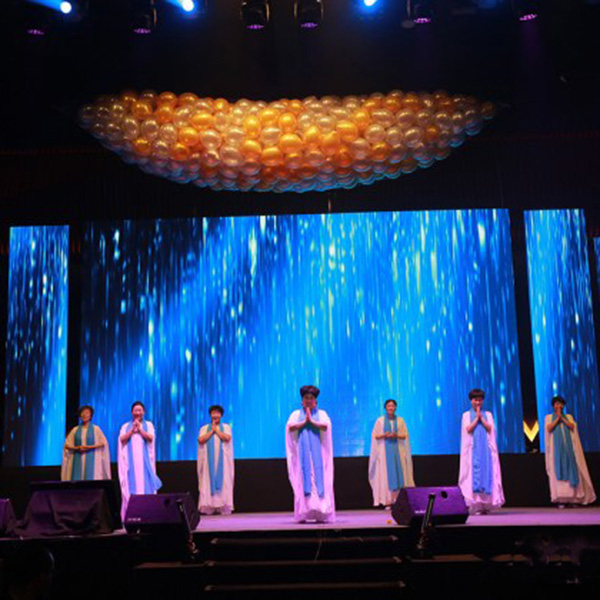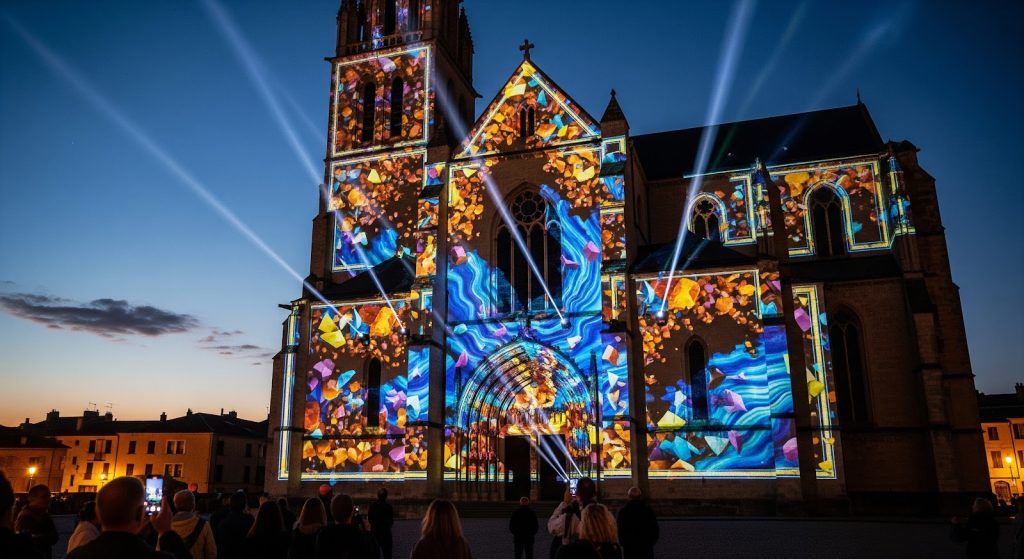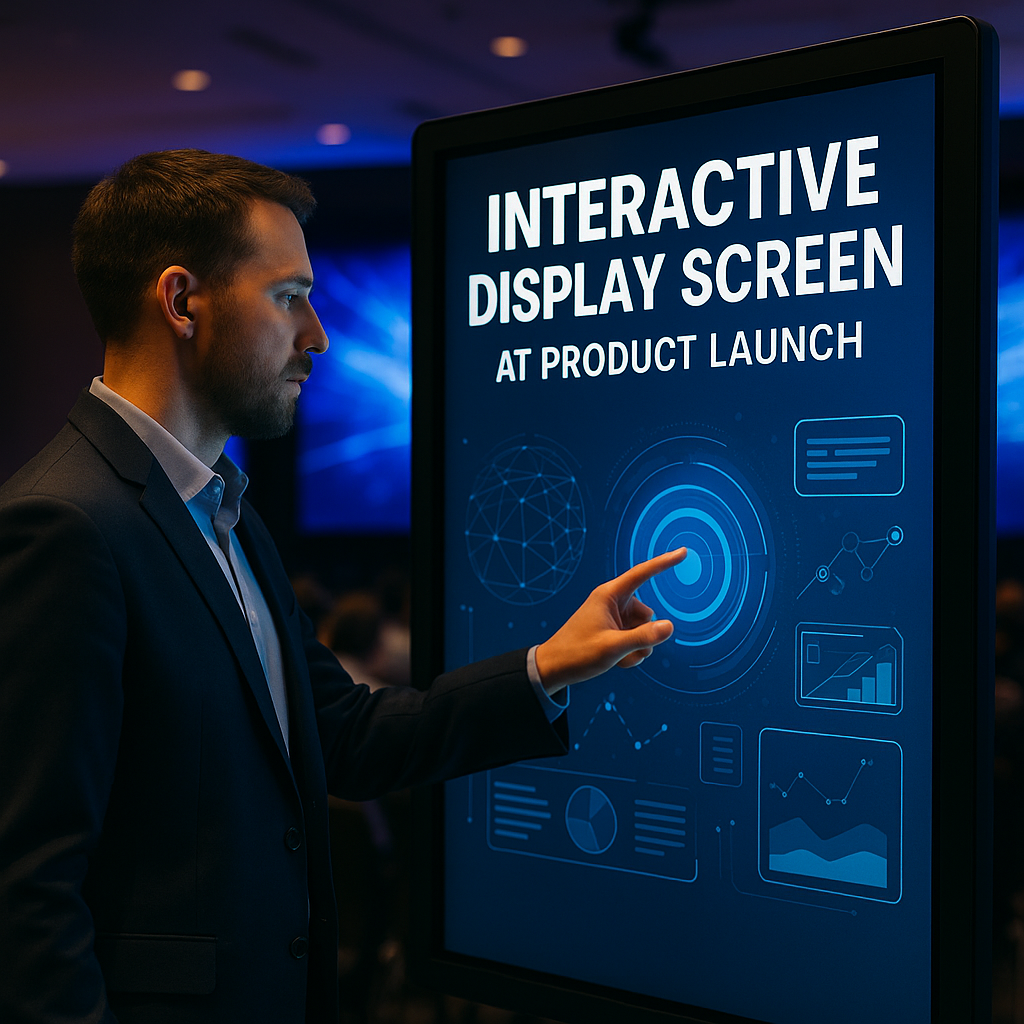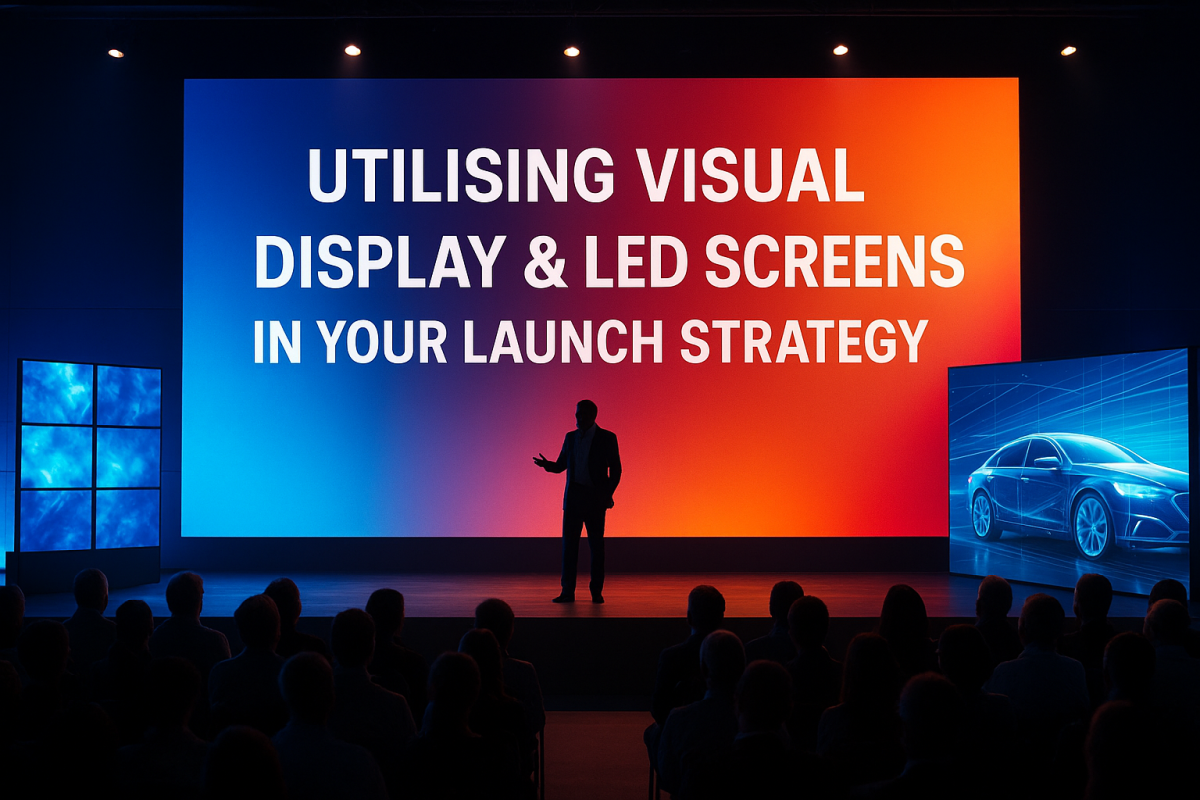Key Takeaways
- Visual displays like LED screens, video walls, and projection mapping turn product launches into immersive, memorable experiences.
- Event display solutions help brands connect emotionally with audiences through impactful storytelling and real-time interactivity.
- Choosing the right visual display unit (VDU)—pixel pitch, brightness, and aspect ratio—ensures clarity and professional quality.
- Interactive display screens boost engagement by inviting participation, sharing, and audience feedback.
- Proper planning, rigging, and power management prevent technical issues and keep displays running smoothly.
- Partnering with a visual display artist merges creativity with technology for stunning, brand-aligned visuals.
- Measure success through engagement data, social reach, and conversions to refine future launch strategies.
Introduction
In a world where attention spans are short and expectations are high, a successful product launch depends on how well you captivate your audience. Using visual display technology—such as LED screens for event launches, video walls, and interactive display screens—brands can transform ordinary unveilings into immersive, shareable experiences.
Modern event display solutions combine creativity and technology to highlight product features, tell brand stories, and build emotional connections. Whether it’s dynamic projection mapping, high-definition visual display units, or large-scale product AV launch equipment, these tools turn launches into memorable moments that drive engagement and visibility.
For companies seeking to stand out, investing in a powerful visual display strategy isn’t just an option—it’s an essential part of today’s launch playbook.
Why “Visual Display” Drives Better Product Launches?
A visual display isn’t just a backdrop—it’s a storytelling tool that influences how audiences perceive and remember your brand. Studies show that people retain up to 80% of what they see compared to just 20% of what they hear, proving why visual display solutions are vital for impactful product launches.
When brands integrate LED screens, video walls, or projection mapping into their launch strategy, they create an immersive environment that enhances emotional connection and message retention. High-quality visual display units help shape first impressions, highlight key features, and deliver the “wow” factor that traditional signage can’t match.
Moreover, modern audiences expect engagement, not observation. By incorporating interactive display screens—touch-enabled walls, motion-responsive visuals, or real-time social integrations—brands can invite participation, spark curiosity, and extend their reach through shareable moments.
Thus, effective use of visual displays transforms a launch from a presentation into an experience—one that excites, educates, and endures.
Event Display Solutions for Product Launches
Choosing the right event display solutions can make or break your launch impact. Today’s audiences expect more than a simple stage setup—they want visual energy, dynamic storytelling, and interactivity that makes them feel part of the event.
From LED screens for event launches to large-scale video walls and immersive projection mapping, each visual element serves a unique purpose in crafting that experience.
LED Screens for Event Launches

LED screens are the backbone of most modern launch events. Their brightness, flexibility, and seamless modular design make them ideal for both indoor and outdoor activations.
With fine pixel pitch and vivid colour reproduction, they ensure your visuals remain crisp and engaging even in challenging lighting conditions. Whether used as a full backdrop, branded stage element, or feature wall, LED displays instantly elevate production value.
Video Walls for Launch Events
When scale and immersion matter, video walls deliver. These expansive displays create an impressive visual canvas that can combine live footage, motion graphics, and promotional content in real time.
They’re particularly effective for large venues or hybrid launches, allowing remote audiences to experience the same impact as those onsite.
Projection Mapping

For launches where creativity takes centre stage, projection mapping transforms ordinary spaces into extraordinary storytelling surfaces.
Buildings, cars, or product models become animated canvases, revealing features, narratives, and emotions through light and motion. Projection mapping is ideal for unveiling flagship products or highlighting innovation in a memorable way.
Interactive Display Screen Options

Image: Interactive display screen
Engagement is everything. Interactive display screens—whether touch, gesture, or mobile-linked—encourage attendees to explore, learn, and interact directly with your brand.
From gamified experiences to digital product demos, interactivity turns passive viewers into active participants and amplifies event buzz on social media.
Together, these event display solutions bring energy, sophistication, and measurable engagement to any product launch—ensuring that your message doesn’t just reach your audience but resonates with them.
Choosing the Right Visual Display Unit (VDU)
Selecting the right visual display unit for your event is about more than just screen size. It’s a technical decision that affects clarity, impact, and audience engagement. The ideal setup depends on viewing distance, venue lighting, and the type of content you’re presenting.
Pixel Pitch & Viewing Distance (Visual Screen Display Basics)
Pixel pitch determines image sharpness. For close-up viewing, such as VIP or indoor product demos, choose a fine pitch between 1–2mm.
For medium to large audiences, a 3–5mm pitch provides excellent resolution without unnecessary cost. A smaller pitch equals smoother, more detailed visuals—essential for premium visual screen displays.
Brightness, Contrast & Color
Indoor LED walls typically range from 800–1,500 nits, while outdoor LED screens for event launches should exceed 3,000 nits to stay bright in daylight. Balanced contrast and accurate colour calibration ensure your product visuals appear true-to-life, even under stage lighting.
Screen Format and Setup
Plan your event display solutions around content. Standard 16:9 displays work well for video, but ultra-wide or curved screens offer cinematic impact for storytelling. Always match your screen’s technical specs with your product AV launch equipment for seamless playback.
Content That Engages Audience on Launch Day
Even the most advanced visual display setup needs powerful content to capture attention. On launch day, the goal is to combine storytelling, motion, and interactivity to keep audiences engaged from the first frame to the final reveal.
Storytelling That Connects
Every launch should have a clear narrative arc—product launches that perform best open with intrigue, build anticipation, and end with a strong visual payoff. Use bold typography, brand colours, and emotive sound design to reinforce key messages.
Motion Design and Visual Rhythm
Short, looping segments (5–10 seconds) work best for event display solutions like video walls and interactive display screens. Use kinetic typography, animated icons, and light transitions to keep energy high without overwhelming the viewer.
Real-Time and Interactive Elements
Incorporate social media feeds, live polls, or AR-triggered content into your LED screens for event launches. Interactivity drives longer dwell time and encourages attendees to share experiences online—turning your display into an amplification tool.
When visuals are purposeful, rhythmic, and responsive, your visual display unit becomes more than a screen—it becomes the heartbeat of your launch.
Logistics & Risk-Control for LED Screens at Events
Behind every flawless launch is detailed planning. Managing LED screens for event launches involves more than setup—it’s about ensuring safety, reliability, and visual consistency from rehearsal to reveal.
Site & Rigging
Before installation, assess stage weight limits, truss capacity, and audience sightlines. Ground-supported structures work best for temporary or outdoor sites, while flown rigs create clean, elevated visuals indoors. Always coordinate with certified riggers to ensure visual display units are secure and aligned.
Power & Signal Management
A stable power supply is critical. Use dedicated circuits and include backup power sources such as UPS systems or generators. Route signal cables separately from power lines to prevent interference, and test redundancy paths for every event display solution.
Content & Playback QA
Schedule a full technical rehearsal. Check playback resolutions, colour balance, and brightness levels for consistency across your video walls or interactive display screens.
Calibrate each LED panel to avoid mismatched tones, and perform an on-site glare test if outdoors.
By planning for safety and contingencies, you ensure your visual display performs flawlessly—delivering high impact without risk.
Measurement: Proving Visual Display Impact
A great visual display doesn’t just look impressive—it delivers measurable results. Tracking the impact of your screens and content helps prove the value of your event display solutions and guides future improvements.
On-Site Engagement
Start by observing how people interact. Do they stop to watch? Take photos? Use QR codes or touchscreens?
Simple tools like heat-mapping cameras or footfall counters can show how many people engaged with your LED screens for event launches or interactive display screens.
Digital Reach
Visual content often extends far beyond the event itself. Track hashtags, mentions, and reposts of your video walls or projection mapping moments on social media. Each share expands your audience and builds buzz long after launch day.
Conversions & Feedback
If your goal is leads or sales, connect your visual display unit engagement to form fills, app downloads, or sign-ups. Post-event surveys and online polls can reveal how memorable or informative the display felt to attendees.
By measuring visibility, engagement, and conversion, you can prove that your visual display didn’t just entertain—it made an impact worth repeating.
Implementation Checklist
To make sure your visual display strategy runs smoothly, follow this quick step-by-step guide:
- Set clear objectives: Define what success looks like—brand awareness, social engagement, or direct conversions.
- Choose your event display solutions: Match LED screens, video walls, or projection mapping to your venue, audience size, and theme.
- Plan your content early: Design visuals to fit your screen’s size, resolution, and aspect ratio. Include short loops, branded graphics, and clear messaging.
- Coordinate product AV launch equipment: Confirm compatibility between playback systems, media servers, and your visual display units to avoid tech issues.
- Test and rehearse: Run full playback checks, test brightness levels, and ensure power backup systems are in place.
- Measure engagement: Track audience interactions, social media activity, and leads generated to assess overall impact.
With solid planning and creative execution, your visual display can transform a launch into a memorable experience that drives excitement and measurable results.
Working with a Visual Display Artist
A successful launch doesn’t just rely on great technology—it relies on creative vision. Partnering with a skilled visual display artist or engaging and event company’s launching services ensures that your screens, projections, and lighting work together to deliver a cohesive story.
These artists specialise in merging brand identity with visual innovation. From animated stage backdrops to projection mapping sequences, they translate product features into visual moments that command attention. Their work bridges design and technology, aligning every visual display unit and LED screen with your brand narrative.
When engaging a visual display artist, start early in the planning process. Share your event objectives, key messages, and technical specs for your product AV launch equipment. This collaboration helps ensure your content is designed to the correct pixel dimensions, colour space, and aspect ratio—avoiding costly reworks later.
A strong creative partnership, transforms your event display solutions from functional to unforgettable—turning light, motion, and sound into an immersive story that defines your product launch.
FAQs
What size LED screen is best for a product launch?
The ideal screen size depends on how far your audience will be from the display. For smaller indoor venues, a fine-pitch LED wall of around 3–5 metres wide usually works well.
For larger or outdoor events, go bigger—10 metres or more—so visuals stay sharp and readable. The key is matching pixel pitch and brightness to your venue’s scale and lighting.
Are video walls or projection mapping better for reveals?
Both are great options, but they serve different goals. Video walls provide bright, high-resolution visuals—perfect for product demos or live feeds.
Projection mapping transforms objects or buildings into moving canvases, ideal for storytelling or dramatic reveals. Many brands combine both for maximum effect.
How bright should outdoor LED screens be?
Outdoor LED screens for event launches should reach at least 3,000 nits of brightness to stay visible in daylight. For direct sunlight, 4,000 nits or higher ensures clear, vibrant images.
Do interactive display screens really increase engagement?
Yes. Interactive display screens encourage participation—through touch, motion, or mobile interaction. This involvement increases attention span, strengthens brand recall, and generates shareable moments on social media.
What is a visual display unit (VDU) in event production?
A visual display unit is any screen, LED wall, or projector that shows your event content. It’s the hardware that brings your visuals to life, connecting your product AV launch equipment with the audience.
Conclusion
In an age where first impressions shape brand perception, using visual display technology effectively can turn a product launch into a landmark event. From LED screens and video walls to interactive display screens and projection mapping, these tools combine creativity and innovation to engage audiences on every level.
By planning carefully, collaborating with a visual display artist, and measuring your results, you can ensure every moment on screen supports your message and strengthens your brand impact.
Ready to elevate your next launch? Explore Rental Supplier’s event display solutions and product AV launch equipment to bring your vision to life with clarity, energy, and unforgettable visuals.
For more, read 15 Launching Gimmicks That Will Leave Your Audience Mesmerised and How To Create an Unforgettable Experience With LED Screens in Events






